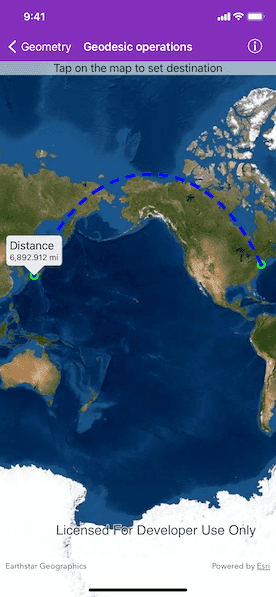Calculate a geodesic path between two points and measure its distance.

Use case
A geodesic distance provides an accurate, real-world distance between two points. Visualizing flight paths between cities is a common example of a geodesic operation since the flight path between two airports takes into account the curvature of the earth, rather than following the planar path between those points, which appears as a straight line on a projected map.
How to use the sample
Tap anywhere on the map. A line graphic will display the geodesic line between the two points. In addition, text that indicates the geodesic distance between the two points will be updated. Tap elsewhere and a new line will be created.
How it works
- Create an
AGSPointin New York City and display it as anAGSGraphic. - Obtain a new point when a tap occurs on the
AGSMapViewand add this point as a graphic. - Create an
AGSPolylinefrom the two points. - Execute
class AGSGeometryEngine.geodeticDensifyGeometry(_:maxSegmentLength:lengthUnit:curveType:)by passing in the created polyline, then create a graphic from the returnedAGSGeometry. - Execute
class AGSGeometryEngine.geodeticLength(of:lengthUnit:curveType:)by passing in the two points and display the returned length on the screen.
Relevant API
- class AGSGeometryEngine.geodeticDensifyGeometry(_:maxSegmentLength:lengthUnit:curveType:)
- class AGSGeometryEngine.geodeticLength(of:lengthUnit:curveType:)
About the data
The Imagery basemap provides the global context for the displayed geodesic line.
Tags
densify, distance, geodesic, geodetic
Sample Code
// Copyright 2018 Esri.
//
// Licensed under the Apache License, Version 2.0 (the "License");
// you may not use this file except in compliance with the License.
// You may obtain a copy of the License at
//
// http://www.apache.org/licenses/LICENSE-2.0
//
// Unless required by applicable law or agreed to in writing, software
// distributed under the License is distributed on an "AS IS" BASIS,
// WITHOUT WARRANTIES OR CONDITIONS OF ANY KIND, either express or implied.
// See the License for the specific language governing permissions and
// limitations under the License.
import UIKit
import ArcGIS
class GeodesicOperationsViewController: UIViewController, AGSGeoViewTouchDelegate {
@IBOutlet private var mapView: AGSMapView!
private let destinationGraphic: AGSGraphic
private let pathGraphic: AGSGraphic
private let graphicsOverlay = AGSGraphicsOverlay()
private let measurementFormatter = MeasurementFormatter()
private let JFKAirportLocation = AGSPoint(x: -73.7781, y: 40.6413, spatialReference: .wgs84())
/// Add graphics representing origin, destination, and path to a graphics overlay.
required init?(coder aDecoder: NSCoder) {
// Create graphic symbols.
let locationMarker = AGSSimpleMarkerSymbol(style: .circle, color: .blue, size: 10)
locationMarker.outline = AGSSimpleLineSymbol(style: .solid, color: .green, width: 5)
let pathSymbol = AGSSimpleLineSymbol(style: .dash, color: .blue, width: 5)
// Create an origin graphic.
let originGraphic = AGSGraphic(geometry: JFKAirportLocation, symbol: locationMarker, attributes: nil)
// Create a destination graphic.
destinationGraphic = AGSGraphic(geometry: nil, symbol: locationMarker, attributes: nil)
// Create a graphic to represent geodesic path between origin and destination.
pathGraphic = AGSGraphic(geometry: nil, symbol: pathSymbol, attributes: nil)
// Add graphics to the graphics overlay.
graphicsOverlay.graphics.addObjects(from: [originGraphic, destinationGraphic, pathGraphic])
super.init(coder: aDecoder)
}
override func viewDidLoad() {
super.viewDidLoad()
// Add the source code button item to the right of navigation bar.
(self.navigationItem.rightBarButtonItem as! SourceCodeBarButtonItem).filenames = ["GeodesicOperationsViewController"]
// Assign map with imagery basemap to the map view.
mapView.map = AGSMap(basemapStyle: .arcGISImageryStandard)
// Add the graphics overlay to the map view.
mapView.graphicsOverlays.add(graphicsOverlay)
// Set touch delegate on map view as self.
mapView.touchDelegate = self
}
// MARK: - AGSGeoViewTouchDelegate
func geoView(_ geoView: AGSGeoView, didTapAtScreenPoint screenPoint: CGPoint, mapPoint: AGSPoint) {
// If callout is open, dismiss it.
if !mapView.callout.isHidden {
mapView.callout.dismiss()
}
// Get the tapped geometry projected to WGS84.
guard let destinationLocation = AGSGeometryEngine.projectGeometry(mapPoint, to: .wgs84()) as? AGSPoint else {
return
}
// Update geometry of the destination graphic.
destinationGraphic.geometry = destinationLocation
// Create a straight line path from origin to destination.
let path = AGSPolyline(points: [JFKAirportLocation, destinationLocation])
// Densify the polyline to show the geodesic curve.
guard let geodeticPath = AGSGeometryEngine.geodeticDensifyGeometry(path, maxSegmentLength: 1, lengthUnit: .kilometers(), curveType: .geodesic) else {
return
}
// Update geometry of the path graphic.
pathGraphic.geometry = geodeticPath
// Calculate geodetic distance between origin and destination.
let distance = AGSGeometryEngine.geodeticLength(of: geodeticPath, lengthUnit: .kilometers(), curveType: .geodesic)
// Display the distance in mapview's callout.
mapView.callout.title = "Distance"
let measurement = Measurement<UnitLength>(value: distance, unit: .kilometers)
mapView.callout.detail = measurementFormatter.string(from: measurement)
mapView.callout.isAccessoryButtonHidden = true
mapView.callout.show(at: mapPoint, screenOffset: .zero, rotateOffsetWithMap: false, animated: true)
}
}